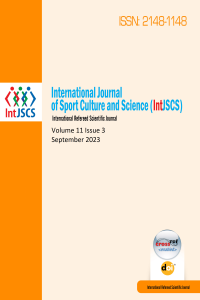Abstract
References
- Fernandez-Fernandez, J., Sanz-Rivas, D., Sanchez-Munoz, C., Pluim, B.M., Tiemessen, I., Mendez-Villanueva, A. (2009). A comparison of the activity profile and physiological demands between advanced and recreational veteran tennis players. J Strength Cond Res, 23(2).
- Gabbett, T. (2016). The training-prevention paradox: Should athletes train smarter and harder? Br J Sports Med 50: 273–280.
- Gabbett, T.J., Mulvey, M.J. (2008). Small field training games and time-motion analysis of competition in elite female football players. J Strength Cond Res 22: 543–552.
- Baiget, E., Fernández-Fernández, J., Iglesias, X., Vallejo, L., Rodríguez, F.A. (2014). On-court endurance and performance testing in competitive male tennis players. The Journal of Strength & Conditioning Research, 28(1), 256-264. Cooke, K., Davey, PR. (2005). Tennis ball diameter: the effect on performance and the concurrent physiological responses. Journal of Sports Sciences, 23(1), 31-39.
- Dokuma, D., Marshall, P., Earle, K., Nevill, A., Abt, G. (2014). Combining internal and external training load measures in professional rugby league. Int J Sports Physiol Perform 9: 905–912.
- Fargeas-Gluck, M.A., Léger, L.A. (2012). Comparison of two aerobic field tests in young tennis players. The Journal of Strength & Conditioning Research, 26(11), 3036-3042.
- Fernandez, J., Mendez-Villanueva, A., Pluim, B. M. (2006). Intensity of tennis match play. British journal of sports medicine, 40(5), 387-391.
- Fernandez-Fernandez, J., Sanz-Rivas, D., Mendez-Villanueva, A. (2009). A review of the activity profile and physiological demands of tennis match play. Strength & Conditioning Journal, 31(4), 15-26.
Investigation of Physiological and Kinematic Parameters of Tennis Players During the Simulated Games
Abstract
In this study, it was aimed to examine the physiological and kinematic parameters of elite male tennis players during the simulated games. Ten male elite tennis players (age: 16.2±3.2 years, height: 179.4±4.7 cm, body weight: 67.3±8.1 kg, sports age: 9.7 years) voluntarily participated in the study. Each player was given two simulated games in the singles category. Research data were collected with the Catapult Sports Vector S7 GPS athlete tracking system, placed in the middle of each player’s shoulder blades. Data were transferred to Openfield Console, and passive recovery periods were excluded. The Mann-Whitney U test was used in the comparative analysis of winner-loser and morning-afternoon games and the significance level was accepted as 0.05. The physiological activity variables of the players during the games were mean and maximum heart rate 144.9±13.5 beats/min and 178.2±11.05 beats/min, respectively; kinematic variables were determined as total running distance 4052.7±1034.3 m, maximum speed 19.01±2.07 km/h, maximum acceleration and deceleration values 3.49±0.42 m/s2 and -3.75±0.61 m/s2. It was determined that these variables did not differ statistically according to winning-losing and morning-afternoon games (p>0.05). The physiological and kinematic responses of elite tennis players differ when two consecutive games are played on the same day. These data may help to elucidate the need for specific pre-competition training loads or recovery strategies when faced with overloaded games. Physiological and kinematic findings obtained during competition are considered to be important for technical teams in planning training programs to improve athletes' performance.
References
- Fernandez-Fernandez, J., Sanz-Rivas, D., Sanchez-Munoz, C., Pluim, B.M., Tiemessen, I., Mendez-Villanueva, A. (2009). A comparison of the activity profile and physiological demands between advanced and recreational veteran tennis players. J Strength Cond Res, 23(2).
- Gabbett, T. (2016). The training-prevention paradox: Should athletes train smarter and harder? Br J Sports Med 50: 273–280.
- Gabbett, T.J., Mulvey, M.J. (2008). Small field training games and time-motion analysis of competition in elite female football players. J Strength Cond Res 22: 543–552.
- Baiget, E., Fernández-Fernández, J., Iglesias, X., Vallejo, L., Rodríguez, F.A. (2014). On-court endurance and performance testing in competitive male tennis players. The Journal of Strength & Conditioning Research, 28(1), 256-264. Cooke, K., Davey, PR. (2005). Tennis ball diameter: the effect on performance and the concurrent physiological responses. Journal of Sports Sciences, 23(1), 31-39.
- Dokuma, D., Marshall, P., Earle, K., Nevill, A., Abt, G. (2014). Combining internal and external training load measures in professional rugby league. Int J Sports Physiol Perform 9: 905–912.
- Fargeas-Gluck, M.A., Léger, L.A. (2012). Comparison of two aerobic field tests in young tennis players. The Journal of Strength & Conditioning Research, 26(11), 3036-3042.
- Fernandez, J., Mendez-Villanueva, A., Pluim, B. M. (2006). Intensity of tennis match play. British journal of sports medicine, 40(5), 387-391.
- Fernandez-Fernandez, J., Sanz-Rivas, D., Mendez-Villanueva, A. (2009). A review of the activity profile and physiological demands of tennis match play. Strength & Conditioning Journal, 31(4), 15-26.
Details
| Primary Language | English |
|---|---|
| Subjects | Sports Science and Exercise (Other) |
| Journal Section | Articles |
| Authors | |
| Early Pub Date | September 30, 2023 |
| Publication Date | September 30, 2023 |
| Published in Issue | Year 2023 Volume: 11 Issue: 3 |


